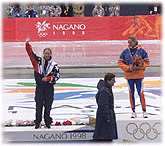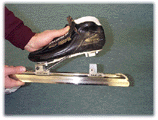TECHNOLOGY AND THE OLYMPIC GAMES
BY TIPPER GORE
Last Thursday in the Big Hat arena in Nagano, I watched Marianne Timmer from the Netherlands win a Gold Medal in the 1000 M Ladies' Speed Skating with a time of 1:16:51, a new Olympic record. A mere twenty-eight hundredths of a second is all that separated her performance from that of Silver Medalist Christine Witty from the United States. Measuring race times with pinpoint accuracy is just one example of how technology has changed the Olympic Games.
Early Olympians did not keep time on Olympic events --their only interest was who won the race. It has only been since 1896 that Olympic officials measured how fast the race was won. Early official times were measured by a handheld watch. In the Stockholm Games of 1912, watches were synchronized with the starter's pistol. By 1932 in Los Angeles, cameras were employed to measure photo finishes. The first fully automated timing system was introduced in the Mexico City Games in 1968, finally replacing the handheld stopwatch for good.

Technological advances don't always require high-tech thinking. The simplicity of the design of the clap skate gives the skater measurable improvements in start times. Similar improvements in design of equipment, such as setting skate blades slightly off center for better cornering and fitted clothing for aerodynamic movements, are common sense advancements.

Just as equipment and technique have advanced athletic performance, developments in Internet technology have revolutionized the flow of information. Nearly 15 years ago my husband coined the phrase &information superhighway8 to describe the potential of the Internet. The prophecy of that phrase is evident today as data and images are transported instantaneously across nations and continents. The Internet and World Wide Web have changed the way we receive our news and subsequently the way these Olympic Games are viewed around the world.
U.S. viewers faced with tape delayed coverage on television due to the 14 hour time difference often opt for the instant results offered on the Internet. Digital photography allows photojournalists to take images from Nagano and post them immediately on the World Wide Web. Conventional photography could take hours and days to reach mass distribution. These are the first Olympic Games to be fully on-line; as recently as the 1996 Summer Games in Atlanta, the technology was still too new.

This technology also offers us unique ways to educate. The U.S. Olympic PBS Cyber School launched by PBS, IBM and CBS provides interactive and cross-curricular exercises for students around the world. It harnesses the excitement of world-class Olympic competition in figure skating, downhill skiing and snowboarding to teach students important science, math and social studies concepts.
As Olympic and world records continue to fall we can only wonder and marvel at the innovations and breakthroughs that lie ahead. Is there a limit? Will the quadruple jump in figure skating one day be compulsory? I think no matter what the technology of the next millennium provides, the ability of the human spirit to push beyond the bounds of physical limitations and achieve the impossible will continue to astound and amaze us. And, we can thank the spirit and the magic of the Olympic Games for bringing us these unforgettable moments.